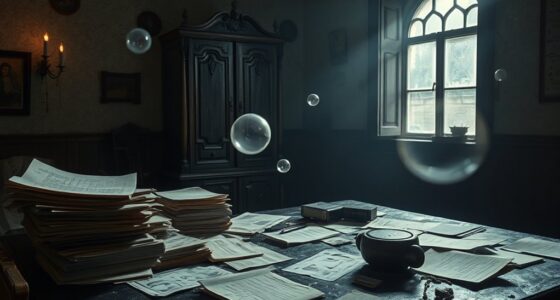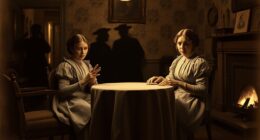In the 1920s, Houdini launched a bold effort to expose fake mediums who used tricks and deception to prey on people’s grief and superstitions. He actively challenged well-known spiritualists, inspected their environments for hidden devices, and demonstrated how illusions like trap doors and concealed props created supernatural effects. His campaigns sparked public debate, increased skepticism, and challenged the spiritualist movement’s credibility. If you’re curious, you’ll discover how Houdini’s methods forever changed the fight against deception.
Key Takeaways
- Houdini actively exposed fraudulent mediums by inspecting environments and revealing hidden devices used to simulate supernatural phenomena.
- His confrontations involved direct challenges, questioning mediums, and scrutinizing props and stagecraft to uncover tricks.
- Houdini’s efforts increased public skepticism of spiritualist claims, exposing techniques like hidden compartments and misdirection.
- The campaign sparked debates, dividing believers and skeptics, and influenced the decline of credibility for spiritualist practices.
- Houdini’s work established foundational methods of modern skepticism, emphasizing critical thinking and rational inquiry against supernatural deception.
The Rise of Spiritualism and Its Influence in the 1920s

During the 1920s, spiritualism gained widespread popularity as many people sought comfort and answers in the aftermath of World War I. As a result, séances became common, and mediums claimed to communicate with the dead. However, this surge in interest also led to an increase in psychic fraud and séance scams. Many mediums used tricks and deception to convince followers they had supernatural abilities, preying on grief and vulnerability. You might have attended a séance expecting genuine contact, only to discover it was a carefully crafted illusion. These scams eroded trust in spiritualists and fueled skepticism. Houdini recognized the prevalence of these fraudulent practices, which motivated his relentless fight against fake mediums and his efforts to expose the truth behind their tricks. The rise of spiritualism also coincided with the growth of vetted Mother Baby Kids products, emphasizing the importance of safety and authenticity in all aspects of life. Recognizing the importance of proper maintenance and detection helped in distinguishing genuine mediumship from deception, much like maintaining equipment to ensure optimal performance and avoid issues. Developing skills in authenticity verification was crucial for discerning genuine spiritual communication from elaborate hoaxes, just as thorough inspections are vital in maintaining quality standards. Additionally, the proliferation of reliable tools for detecting fraudulent practices underscored the need for rigorous standards in both spiritual and practical domains. In this context, understanding the psychology behind narcissistic manipulation can also shed light on how some mediums exploited audiences’ emotions for personal gain.
Houdini’S Early Encounters With Mediums and Spiritualists

Houdini’s fascination with the world of spiritualism began early in his life, driven by curiosity and skepticism. As a young man, he attended séances, enthusiastic to see if communication with spirits was real. Instead, he quickly recognized psychic fraud and séance tricks designed to deceive the unsuspecting. He observed how mediums used hidden devices, quick hand movements, and cleverly concealed props to fake spirit appearances. Houdini’s natural skepticism fueled his desire to expose these tricks, and he began practicing his own illusions to understand how they worked. His early encounters revealed the widespread use of deception in spiritualist circles, reinforcing his belief that most mediums relied on sleight of hand rather than genuine supernatural powers. These experiences laid the groundwork for his later crusade against fakery. Recognizing the importance of color accuracy and lighting in illusions, Houdini meticulously studied how visual elements could be manipulated to deceive audiences. Additionally, he learned that understanding visual deception techniques was crucial for both creating and exposing illusions. This knowledge helped him develop a keen eye for deceptive practices, enabling him to see through even the most sophisticated tricks employed by fraudulent mediums. Furthermore, Houdini understood that psychological manipulation often played a role in convincing audiences of supernatural phenomena, which he sought to demystify through his performances. To deepen his understanding, Houdini also studied the history of spiritualism to better identify common methods and patterns used by con artists.
Techniques Used by Fake Mediums to Deceive the Public

Fake mediums rely on a variety of clever techniques to convince the public they can communicate with spirits. They often use psychic fraud tactics, such as cold reading, where they pick up on subtle cues and guesses to appear intuitive. Illusion techniques are also common, including hidden compartments, trap doors, or cleverly concealed objects that produce “spiritual” messages. Some mediums manipulate physical objects like tables or cards, creating the illusion of spirits’ presence. They may also employ clever stage props and misdirection to distract audiences and hide their tricks. By combining these methods, fake mediums create convincing but false impressions of supernatural communication, fooling the public into believing they possess genuine psychic abilities. Additionally, some fake mediums exploit psychic fraud tactics to deepen their deception and enhance the illusion of supernatural powers. They often capitalize on seasonal variations and other environmental factors, such as lighting and acoustics, to amplify their effects and mislead their audiences. Furthermore, techniques like misdirection and audience manipulation are frequently used to maintain the illusion of authenticity and keep viewers engaged. To heighten their credibility, some mediums also use advanced stagecraft, incorporating modern technology to simulate supernatural phenomena convincingly. Their understanding of psychological manipulation enables them to better exploit audience expectations and biases, making their deceptions more convincing.
Houdini’s Methods for Exposing Fraudulent Mediums

Houdini knew that frauds often relied on hidden devices and clever tricks to fool the public. You can spot these by carefully inspecting for concealed tools or unusual equipment. Challenging the medium’s claims directly helps reveal whether they’re truly genuine or just master illusionists. Incorporating alternative investments like gold can also serve as a safeguard against economic deception and instability.
Spotting Hidden Devices
To uncover hidden devices used by fraudulent mediums, you need to pay close attention to their environment and the methods they might employ. Look for anything out of place—small holes in walls, unusual objects, or suspicious wires. Fraudulent mediums often hide microphones in picture frames, behind loose wallpaper, or inside books. Concealed cameras might be hidden within decorative items, such as clocks or vases. Use a flashlight to scan the room carefully, checking for tiny lenses or reflective surfaces. Stay alert to any sounds or movements that seem out of place. Houdini knew that spotting these subtle clues helped expose deception. By meticulously inspecting the surroundings, you make it much harder for mediums to hide their devices and maintain the illusion of supernatural powers.
Challenging Medium’s Tricks
Exposing a fraudulent medium requires more than just spotting hidden devices; it demands actively challenging their tricks and methods. You need to understand their illusion techniques and how they create psychic hoaxes. Instead of passively observing, you confront the medium directly during a séance, asking pointed questions or testing their responses. Houdini often used misdirection to reveal their secrets, catching them off guard. By scrutinizing their props and methods, you can expose how they manipulate objects or feign supernatural powers. Challenging their tricks involves skepticism and a keen eye for deception. You look for inconsistencies in their claims, revealing how they use simple illusions to deceive the untrained. This active approach helps differentiate genuine spiritual communication from elaborate hoaxes.
Notable Confrontations With Well-Known Mediums of the Era

Throughout his crusade against fraudulent mediums, Harry Houdini engaged in several high-profile confrontations with some of the era’s most famous spiritualists. He exposed psychic frauds that relied on hidden devices, secret codes, and clever tricks to create illusions of communicating with the dead. One notable confrontation involved Mina Crandon, known as “Margery,” whose séances Houdini claimed were riddled with spiritual deception. He publicly challenged her, debunking her methods and revealing how she faked her trance states. These encounters weren’t just about exposing tricks; they aimed to protect the public from deception and false hope. Houdini’s efforts made him a fierce opponent of the con artists exploiting grief and credulity through fake spiritualist practices.
Public Reactions and Media Coverage of Houdini’s Campaign

How did the public and media respond to Houdini’s relentless campaign against fraudulent mediums? Public perception was mixed; many admired Houdini’s efforts to expose deception, seeing him as a hero fighting spiritual fraud. However, skeptics and spiritualist supporters accused him of undermining genuine communication with the dead. Media sensationalism played a significant role, with newspapers sensationalizing Houdini’s stunts and debates, often framing him as a crusader or a menace. Headlines fueled controversy, amplifying the drama surrounding his confrontations with mediums. While some readers celebrated Houdini’s honesty and bravery, others dismissed him as a skeptic ruining innocent believers’ hope. Overall, his campaign sparked widespread discussion, shaping public opinion and fueling the era’s ongoing debate over spiritualism and fakery.
The Impact of Houdini’s Efforts on the Spiritualist Movement

Houdini’s relentless campaign against fraudulent mediums considerably shaped the spiritualist movement, polarizing public opinion and forcing it to confront its own practices. His exposes fueled mediumship skepticism, leading many to question the authenticity of spiritualist claims. Some followers experienced a spiritualist revival, seeking genuine connection beyond deception, while others grew disillusioned and abandoned the movement altogether. This divide created a tumultuous atmosphere within spiritualism, challenging its credibility and future. The table below captures the emotional impact of Houdini’s efforts:
| Hope for Truth | Disillusionment | Renewed Faith |
|---|---|---|
| Belief in genuine spirits | Loss of trust in mediums | Seeking authentic contact |
| Spiritual awakening | Betrayal and skepticism | Reaffirmation of true mediumship |
| Confidence in spiritualism | Disillusionment with fraud | Rejuvenation of belief |
| Faith in the unseen | Cynicism about practitioners | Hope for honest mediums |
| Emotional turmoil | Frustration, anger | Peace through authenticity |
Legacy and Continuing Relevance of Houdini’s Battle Against Deception

Houdini’s relentless fight against fraudulent mediums has left a lasting legacy that continues to influence both skepticism and spiritualist practices today. His exposure of illusion techniques and psychological manipulation revealed how easily people could be deceived. You can see his impact in modern debunking methods, where understanding illusion and manipulation helps distinguish genuine phenomena from trickery. Houdini’s efforts fostered a culture of critical thinking, encouraging people to question supernatural claims. His legacy reminds you to look beyond surface appearances and recognize the sophisticated techniques used to exploit belief. Even today, magicians and skeptics draw inspiration from Houdini’s work, using his principles to combat deception and promote rational inquiry. His battle against fake mediums remains a powerful symbol of integrity and scientific skepticism.
Frequently Asked Questions
How Did Houdini First Become Interested in Exposing Mediums?
You become interested in exposing mediums after witnessing seance deceptions and spiritualist fraud firsthand. Houdini was skeptical of the paranormal and believed many mediums used tricks to deceive people. His curiosity grew as he saw how easily people fell for these scams, inspiring him to uncover their methods. By exposing these frauds, he aimed to protect the public from being duped and to promote scientific skepticism.
What Specific Tools or Techniques Did Houdini Use During His Investigations?
They say “trust but verify,” and Houdini knew that well. During his investigations, he used tools like smoke and mirrors and sleight techniques to uncover deception. He carefully examined mediums’ props, exposed hidden wires, and analyzed their routines to reveal tricks. Houdini’s keen eye and mastery of illusion allowed him to see through fakery, proving that many claimed supernatural powers were just clever illusions.
Did Houdini Collaborate With Other Skeptics or Organizations?
You might wonder if Houdini collaborated with skeptics or joined organizations. He actively formed skeptic alliances and partnered with groups like the Scientific American Committee for the Investigation of Claims of the Paranormal. Houdini believed in exposing frauds through these organization partnerships, which strengthened his efforts. His collaborations helped legitimize skepticism, making him a key figure in the fight against fake mediums and spiritualists.
How Did Mediums Adapt Their Tricks in Response to Houdini’S Exposures?
You see, mediums adapted their tricks by refining their stage illusions and psychological tricks, making it harder for skeptics to expose them. They started using more subtle methods, such as hidden compartments and clever misdirection, to maintain the illusion. By evolving their techniques, they continued to deceive audiences, even when Houdini exposed many of their methods. This constant adaptation kept their performances convincing and maintained their mystique.
What Long-Term Effects Did Houdini’S Campaigns Have on Spiritualist Practices?
Imagine a lighthouse piercing through fog, guiding ships away from hidden rocks. Houdini’s campaigns cast a long shadow over spiritualist practices, fueling public skepticism and challenging long-held beliefs. As a result, many genuine practitioners faced increased scrutiny, forcing spiritual traditions to adapt or fade. His efforts sparked a lasting shift, transforming society’s view of mediums, and leaving a legacy of critical thinking that still influences spiritual exploration today.
Conclusion
You can see how Houdini’s relentless fight against fake mediums reshaped public trust, exposing over 100 fraudulent spiritualists. His efforts not only discredited many con artists but also sparked skepticism that still influences spiritualism today. By revealing deception, he safeguarded the truth and challenged false hopes. His battle reminds you that even in a world enthusiastic for miracles, critical thinking and investigation remain your strongest tools to uncover reality.









